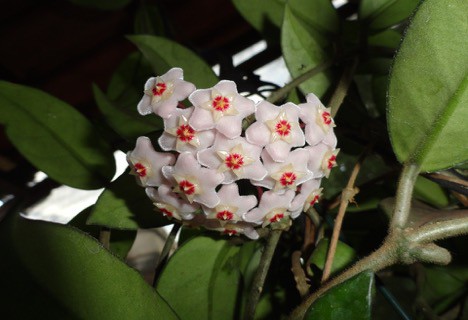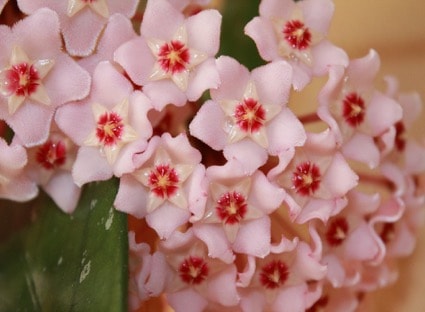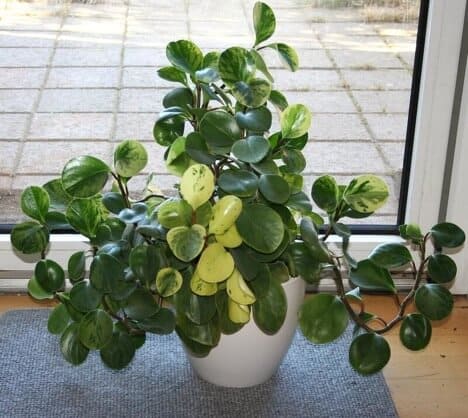Hello gardeners! In this article, you can learn how to take proper care of your Hoya australis plant. If you are already an experienced Hoya grower, reading this article will be very helpful for you too. We would like to provide some tips and secrets that will make your Hoya australis thrive.
Hoya Australis is a tropical plant that can be grown indoors or outdoors as long as it gets enough sunlight daily. It belongs to the Hoya genus and is also called Starry night hoya. It can be easily identified by its yellow/green leaves with a lovely green rim, white flowers, and red berries.
Read on and make sure to follow our Hoya australis care guide to ensure that your Hoya is happy and healthy!
Table of Contents
Hoya Australis Origin: What is Hoya Australis?
Hoya australis (star hoya, Australian waxplant) is a climbing vine with waxy leaves and small flowers. This plant belongs to the genus Hoya, and it's native to eastern Australia and New Zealand. It can grow up to 10 ft (3 m).
There is an evergreen perennial forming an underground tuber from which grow thick roots and pale green stems. Pointed leaves are arranged spirally up the stem. The leaves have a distinct odor when crushed.
Related Post: Hoya Krimson Queen Care
Hoya australis has star-shaped, white scented flowers throughout summer and autumn, often in great numbers. They are followed by round berries, which ripen from green to red over the course of winter. In cultivation, it is easily grown in pots or hanging baskets.
| Scientific name | Hoya australis |
| Popular name | Starry Night Hoya, Australian waxplant, Aussie hoya |
| Family | Apocynaceae |
| Genus | Hoya |
| Origin | Australia, New Guinea, Malaysia, and the Philippines |
| Height | Up to 2 m (6 feet) indoors, spreading to 3 or 4 feet outdoors |
| Hardiness zone | Hardy to zone 10-11 |
| Growth rate | Slow – Medium |
| Toxicity | It is non-toxic to humans and other mammals; however, all parts are considered toxic if ingested |
| Where to get it | You can buy a hoya australis plant from better nurseries and garden centers, as well as on some online stores |
Hoya Genus Description

Hoya genus has about 350 species! The most common are the wax hoya, curly leaf hoya, kiwi hoya, and others. All of them are tropical plants that require high humidity levels daily.
Hoya plants have waxy leaves and flowers that are often white. If you touch the waxy leaves, they can be very slippery, which is how these plants got their name (wax-like).
What is really interesting about hoya plants is that their flowers emerge from leaf axils instead of bare branches or flower stalks which make them unique compared to other plants.
Recent studies have shown that some hoya plants are helpful in purifying indoor air.
Here are some popular Hoya varieties:
- Hoya australis (Hoya, starry night hoya): yellow-green leaves with green rims; white flowers; red berries.
- Hoya carnosa (bear trap hoya, wax plant): thick waxy leaves; small white or pink flowers; available in many colors.
- Hoya kerrii (wax kerrii, wax princess): yellowish leaves with red or purple veins; white flowers; growing up to 5 feet tall.
- Hoya pubicalyx (string of buttons hoya): round green leaves; small white flowers; often used for flower arrangements.
- Hoya obovata (hobble hoya)yellowish or green-purple leaf; small pink flowers.
- Hoya shepherdi (dancing doll hoya) green leaves; white flowers with red centers.
- Hoya carnosa "Rubra" (red wax plant, blood leaf): thick waxy red leaves that secrete a sticky substance when broken or touched.
Where to Grow Hoya Australis?
You can grow your Starry Night Hoya in the ground or in a pot. In order to have a thriving Hoya australis, you need to choose the right place for it to grow.
Hoya plants are tropical vines that thrive when they get enough sunlight daily and high humidity levels all year round.
In other words, if you're living in a location with cold winters and long periods of no humidity, you'll need to grow your Hoya in a pot and indoors.
Hoya Australis Care And Growing Tips

Below is everything you need to know when it comes to growing a healthy Hoya australis plant and taking good care of it.
Following this Hoya australis care guide, you will find the entire process effortless and fun.
Let’s get started!
Related Post: How to Grow Hoya Krimson Princess
Hoya Australis Light Requirements
Hoya australis doesn't like too much sunlight and prefers filtered or indirect light. If you place it in full sun, be sure to rotate the pot regularly so that all sides receive an equal amount of sunlight. Avoid placing your Hoya close to a west-facing window where it can get scorched.
Artificial light can also suffice if you keep the plant where it's bright enough but not too close to a source of heat.
Temperature Requirements
As for temperature, Starry night hoya needs the same conditions as humans – it needs to be kept at room temperature and not be exposed to extreme cold or heat.
You can grow Hoya australis at any indoor temperature as long as there is enough natural or artificial light. However, it is best to place your plant in an area where the temperature is between 50-90°F (10-32°C).
Protect it from frost and cold windows.
Hoya Australis Watering Requirements
Starry Night Hoya needs to be watered when the soil surface dries up. Over-watering, however, is a no-no! Avoid overwatering your Hoya australis at all costs, and don't let the plant stand in water after watering.
If you overwater your Hoya, the leaves quickly turn yellow or brown and fall off; then, new leaves grow, but they are deformed. The plant may also stop flowering. If this happens, immediately stop watering your Hoya until the soil surface appears dry.
If you notice and crinkled leaves, it means that your Hoya isn't receiving enough water.
Poor drainage is the #1 reason why Hoya australis dies. Make sure that the flower pot or container has enough drainage holes to let water flow freely.
Humidity and Air Circulation
Hoya australis loves humidity, so place the pot on a tray of wet gravel or pebbles to raise the humidity around it. You can also mist your plant regularly.
If you have central air conditioning, keep this plant away from it because cold air dries out the leaves quickly, making them turn brown.
Soil
Hoya australis forms a large fleshy root, so drainage is essential. Use a soil mixture composed of good-quality potting soil to one part coarse sand or perlite.
This will ensure proper drainage. The flowering pot or container should have enough drainage holes.
Fertilizing
Because hoya australis doesn't need to be fed frequently, it's a good idea to feed the plant only every 2 months during its growing season (spring and summer).
You can use any balanced fertilizer diluted to ¼ or ⅛ of the recommended dosage.
Repotting
It is best to repot Hoya australis every two years or so because it doesn't like being pot-bound. You can repot your plant during spring once the threat of frost has passed.
Repot high enough so that new roots won't have to grow out of the drainage holes.
Pruning
You can prune hoya australis during spring or summer by cutting back long stems to about 30 cm (12 in) from the soil level.
This will encourage new growth and will also increase air circulation around your plant, which helps prevent diseases like powdery mildew.
Hoya Australis Propagation

Hoya australis can be propagated by cuttings. You'll need to give the stem cuttings about 2 months for new roots to set before planting them in pots or containers.
Related Post: Hoya Krimson Queen Vs Princess {9 Key Differences}
Procedure for propagation:
- First, you'll need to cut a healthy stem about 10 cm from the main stem.
- Remove all leaves except the topmost pair at the very tip of the cutting.
- Take a jar and pour some water into it.
- Cover that jar with foil and make a few holes in it to place cuttings.
- You can also put your Hoya australis cutting in a pot of perlite or medium-grade potting soil and cover it with about 2 cm (0.8 in) of soil. Keep the cutting humid by covering it with a plastic bag until new roots appear.
- Let your Hoya australis for 2 weeks to form callus before planting it. Use rooting hormone powder if you want to encourage a faster-rooting process.
Pests and Diseases
Hoya australis is susceptible to attack by scale insects, thrips, mealybugs, aphids, and mites. Treat these with a pesticide of your choice.
Remember: Never use harsh chemicals on any part of the hoya australis plant because it could be deadly to its sensitive leaves and stems.
Hoya Australis Problems
Hoya Australis Leaves Start Turning Yellow?
If your hoya australis plant leaves start turning yellow, don't panic. This condition is usually caused by old age, low humidity, overwatering, or underwatering.
You can try to increase the humidity around the plant by placing it on a tray of pebbles, put some water in the tray and make sure that it doesn't touch the bottom of the pot.
When you notice brown tips on young leaves, don't worry because this is due to sudden temperature changes or dry air.
You can avoid these conditions by keeping your Hoya australis away from cold windows; also, mist them regularly using room-temperature water. Inadequate soil drainage can also cause leaves to brown at the tips.
What if Hoya Australis Leaves are Turning Brown?
Brown tips on hoya australis leaves can be caused by dry air, extreme temperature changes, or too much exposure to the sun.
You can try misting your plant regularly using room-temperature water; you can also place it in a tray of pebbles and add some water without allowing the pot to touch the bottom of the tray.
Ensure that all drainage holes are clear so that excess water won't build up around your plant.
If brown spots appear on leaves, it means there's not enough humidity in the air because hoya australis thrives in humid conditions.
You can increase humidity around this plant by placing it on a tray of pebbles or rocks and put some water in it without letting the pot sit in the water. Never overwater your Hoya australis because it will cause root rot which can kill it fast.
What if Hoya Australis Flowers Are Drooping?
Your Hoya australis flowers could droop due to low temperature, too much or too little light, and dry air.
Increase humidity around this plant by misting; you can also place it in a tray of pebbles and add some water without allowing the pot to touch the bottom of the tray.
Low temperatures can be resolved by moving your plant somewhere warmer (around 70°F). If there's not enough light in the room, move your plant near a window where it will get direct sunlight for at least 4 hours daily.
Make sure that the window doesn't face west because this area is prone to harsh sun rays.
Frequently Asked Questions
How do I know if a Hoya australis has bugs?
A hoya australis plant is very susceptible to the attack of bugs because its leaves are sensitive. If you notice any black dots on the leaves, it means you have bugs. To remove these insects, cut off the infected parts and drop them in alcohol or cigarette ash.
Why is my Hoya australis not blooming?
If your hoya australis plant isn't blooming even if it has healthy-looking leaves, check for insects first; there might be ants invading your plant, which can kill it fast if not removed right away.
If no insects are crawling on your Hoya australis, then check for possible causes that could affect its life span: root rot may cause wilted leaves; don't overwater your Hoya australis because it might cause root rot; the low temperature can also cause wilted flowers and leaves.
Why is my Hoya australis dying?
Hoya australis can die due to pests, diseases, and too much or not enough care. If your plant is drooping, check if it has pests such as mealybugs or scale insects because these infestations stress out hoya australis plants. You can also tell that there are pests around based on sooty mold which appears on the leaves.
If you see dark brown spots appearing on young leaves, it means you have bacterial black spot; this condition will cause leaf loss. Brown tips on hoya australis leaves could mean spider mites; this condition causes severe leaf damage, eventually leading to death.
Final Thoughts about Hoya australis
Hoya australis is one of the easiest hoya plants to care for. This plant is also known as "the waxplant" because of its thick leaves, which resemble candles, and it thrives well in medium-light conditions and cool temperatures ranging from 65°F to 75° F.
Never place this Hoya plant near a hot or cold window. Keep these tips in mind to keep your Hoya australis healthy and blooming year after year!
How do you feel about this article? Is there any information that you want added or removed? Please share your opinions with us! You can leave any questions, suggestions, or feedback.
Read Also: Different Philodendron Types




